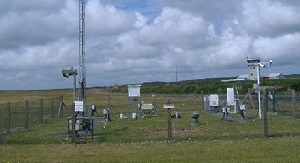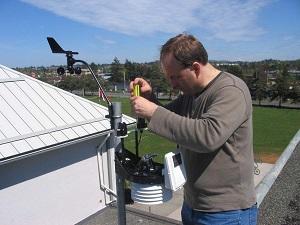Every professional weather station comes with an outdoor sensor suit, which is necessary to be mounted outdoors. Installation is the vital aspect of a weather station to maintain accuracy, so the sensor should also be installed at the correct position. There are various mounting options, and users often get confused about which location to select. Some houses have a concrete roof that cannot be penetrated, or some have larger free space for ground mounting. The placement should be done according to the possibilities and comfort. So to make your work easier, we are here to provide you with ideas about some of the most common mounting options.
Ground Mounting on Grass or Dirt

If you have a home business in some rural site, it is apparent to have a lot of free space for you to install the weather station at your yard itself. The unit can be mounted on a tripod, and it can be fixed as per the mounting rules. It is one of the most common and most accessible options for establishing a weather station. A mounting tripod or pole can be used for this. You can use stakes to ensure the stability of the stand.
Advantages
- You can mount the weather station without much labor and any professional help
- The weather station sensor unit will be easy to reach for routine maintenance
- Accurate data right from your yard
Disadvantages
- The weather station unit will be accessed by anyone who visits you, so there is a tampering risk every time
- It needs a significant area and free space, without any obstruction for very long distance
- You have to take extra care of the distance between the grass and the units if any
- The weather station sensor shouldn’t fall under the shaded area
Ground or Roof Mounting on Concrete Floor
Some ground floors are cemented, and most of the roofs are made of concrete. Many consider mounting the weather station also on the cemented floor or terrace if there is enough free space without much obstruction. For this, you can use a non-penetrating mount, which has been specially designed for a flat roof. For ballast, almost all the non-penetrating mounts come with a stable platform containing cinder blocks.
Advantages
- It makes the installation easier as no penetration is required to mount the system
- Easy to maintain and can be moved quickly whenever needed
- No professional help is necessary for installing the whole weather station system
Disadvantages
- The weather station is not permanently fixed; in case of storms or heavy wind, the position of the system might be affected
- Adding additional mast can be a little problematic if the system comes with separate units
Pitched-roof Mounting
Pitched-roof mounting is the best solution for those who have lesser space and a non-concrete roof, for installing the outdoor weather station suit. In this, the weather station stand can be attached to the tar pads using screws. Holes are drilled on the roof, and the pads with the sensor suit stand are mounted on the roof.
Advantages
- The weather station system in this type of mounting is fixed permanently high above on the roof, so there is very less tampering risk
- The system will not be easily affected even if there is substantial wind or storms
Disadvantages
- The installation will take much time as the process is lengthy
- You will need professional help, if not a weather station expert; you will at least need a plumber to fix the roof
- Maintenance can be an issue as you won’t be able to access the system easily
- The holes in the roof need proper sealing; there may be water leakage through the roof during rainfall
Eave Mounting
The eave is one of the most common locations for mounting weather stations. Usually, some sensors are especially recommended to be installed at the eave, but if you have lack of space or in case pitched-roof mounting is not possible for you, it is best to go for eave mounting. For eave mounting, there are unique weather station sensor suit stands that come with a horizontal offset to hang the system accurately.
Advantages
- Needs no extra space for installation
- Perfect spot for sensitive sensors
- Suitable for weather stations with low transmission distance
Disadvantages
- Professional help may be necessary
- The mount must be reliable and it should be done properly
- Some stands with smaller offset may block the gutter and overhang
Chimney Mounting
Many users also prefer mounting their weather station system on the chimney. If your system’s transmission distance is high enough and you want to keep it at a maximum length away from any obstacle, then it is best to go for chimney mounting. For the installation at the chimney, individual chimney mounting pole is available in the market. Some poles are designed to be permanently mounted on the stack by drilling in it, and there are also some poles that come with straps, which are used to strap-attach the mounting pole to the vent.
Advantages
- The weather station sensors are placed far from any obstruction; hence there is more possibility of accuracy
- No risk of manual tampering as the system would be out of reach from other individuals
- No extra space is necessary
Disadvantages
- Professional help may be required
- The heat from the chimney may melt some of the plastic components of your weather station, resulting in an inaccurate reading of the weather variables
- It would be difficult to access the weather station for routine maintenance
Fence Post and Side of Building or Wall
If you have a stable and robust fence post, then you can go for this. The side of the building or wall can also be a perfect spot for mounting a weather station sensor system, basically if you have no other options and if your weather station system needs regular maintenance. For this, you can use a secure and stable mounting kit with a horizontal offset to mount the system. The package can be attached by drilling the side and fixing it with lag screws.
Advantages
- The weather station can be accessed easily
- No extra space is necessary for mounting
Disadvantages
- The system might tilt if the mounting is not done accurately, which may let to inaccurate readings
- Professional help might be required
- If the distance is not maintained and the height of the mast is too short, then the texts might be affected
Chain Linked Fence Mounting
Chain linked fence is a ubiquitous location to mount a weather station. For some industrial or farm site, chain related fence is the ideal fencing choice. For this, it might be a little tricky to choose the right mounting system. You can get a mount that can be mounted on the post of the fence.
Advantages
- An ideal solution for those who have lesser space and tall objects around
- The weather station will be easily accessible for maintenance
Disadvantages
- There will be a risk of tampering by passersby
- Not all mounting system is compatible with this type of mounting
Mast to Mast Mounting
Usually, people already have other necessary units like radio or TV antenna. It is also possible to mount the weather station on the existing mast if the antenna is sturdy. Even, an existing flagpole is perfect for installing a weather station system. For this type of mount, you can use a stand-off to connect one mast to the other mast.
Advantages
- No extra space is required
- A stand-off is available in varieties of sizes with different diameter lengths
Disadvantages
- Transmission may be affected at times
- The existing mast must be sturdy and strong
Marine Mounting
These days weather stations are not only used for home or office, but weather stations can also be mounted on boats. The Marine environment is visible to be very harsh as the units will be exposed to the most stringent weather conditions such as heavy storms and also rainfall. There are specially designed mounting kits that are stainless and strong.
Advantages
- Mounting the weather station in your boat will help you know the weather conditions accurately and help you plan your day
Disadvantages
- You will have to drill holes in your ship to mount the unit
- Due to jerking of the boat, the screws may often loosen
Automobile Mounting
Many people also install their weather station on their automobile or recreational vehicle. Weather stations can be a great help for those who frequently move around on their large car and spend most of the time in it. You can easily find some simple, fast and portable weather station mounts available at the market.
Advantages
- You can take your weather station system wherever you travel in your automobile or RV
- Plan your day perfectly
Disadvantages
- Professional help may be required in the installation
- Due to excessive movement, the data may not be accurate when the vehicle is moving
Conclusion
You have seen that there are varieties of mounting options for you. It is not essential that a particular mounting system is designed for a single type of mounting. It is up to you to decide which suits the best for your location and accommodation. We hope this article has helped you to figure it out.

Need help in setting up my Remote so t hat it will connect with my station and also how to mount the remote. Did not receive the hardware to mount it with
It also does not have the atomic signal working